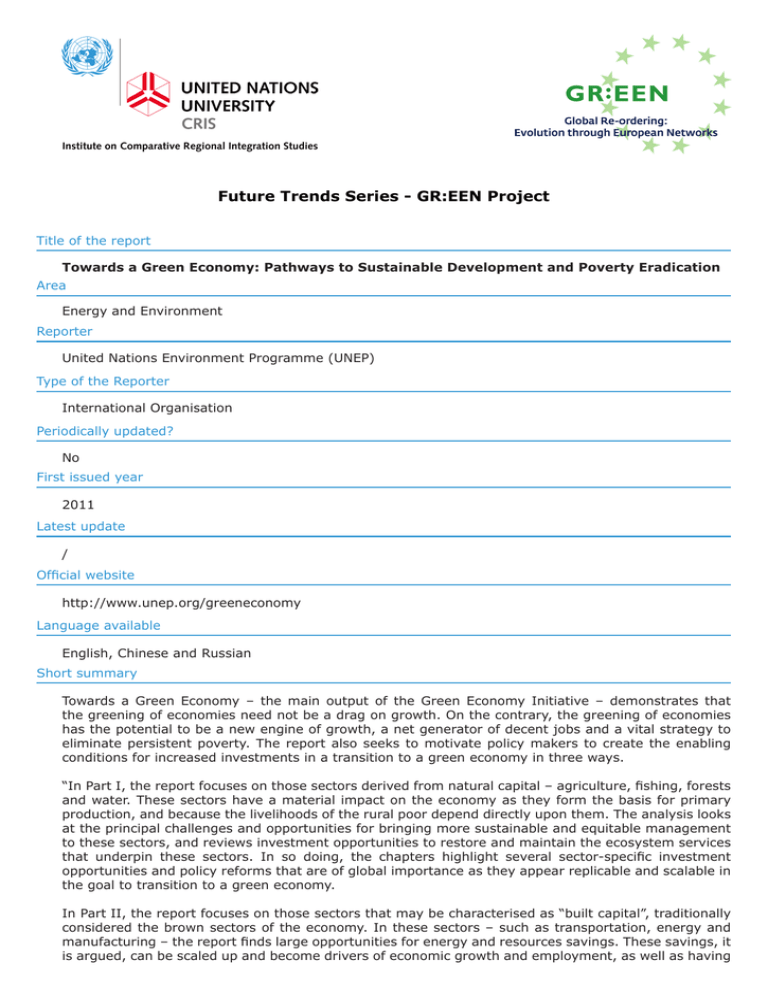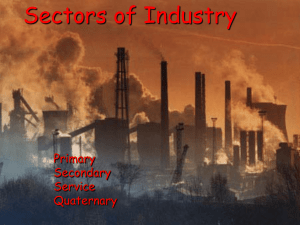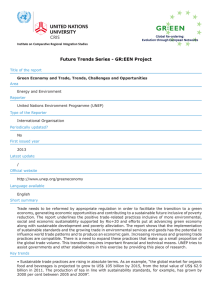Future Trends Series - GR:EEN Project
advertisement

Future Trends Series - GR:EEN Project Title of the report Towards a Green Economy: Pathways to Sustainable Development and Poverty Eradication Area Energy and Environment Reporter United Nations Environment Programme (UNEP) Type of the Reporter International Organisation Periodically updated? No First issued year 2011 Latest update / Official website http://www.unep.org/greeneconomy Language available English, Chinese and Russian Short summary Towards a Green Economy – the main output of the Green Economy Initiative – demonstrates that the greening of economies need not be a drag on growth. On the contrary, the greening of economies has the potential to be a new engine of growth, a net generator of decent jobs and a vital strategy to eliminate persistent poverty. The report also seeks to motivate policy makers to create the enabling conditions for increased investments in a transition to a green economy in three ways. “In Part I, the report focuses on those sectors derived from natural capital – agriculture, fishing, forests and water. These sectors have a material impact on the economy as they form the basis for primary production, and because the livelihoods of the rural poor depend directly upon them. The analysis looks at the principal challenges and opportunities for bringing more sustainable and equitable management to these sectors, and reviews investment opportunities to restore and maintain the ecosystem services that underpin these sectors. In so doing, the chapters highlight several sector-specific investment opportunities and policy reforms that are of global importance as they appear replicable and scalable in the goal to transition to a green economy. In Part II, the report focuses on those sectors that may be characterised as “built capital”, traditionally considered the brown sectors of the economy. In these sectors – such as transportation, energy and manufacturing – the report finds large opportunities for energy and resources savings. These savings, it is argued, can be scaled up and become drivers of economic growth and employment, as well as having important equity effects in some cases. Resource efficiency is a theme that has many dimensions as it cuts across energy efficiency in manufacture and habitation, materials efficiency in manufacture, and better waste management. Finally, after providing an in-depth overview of the modelling conducted for this report and before examining options for financing the green economy, part III focuses on enabling conditions for ensuring a successful transition to a green economy. These include appropriate domestic fiscal measures and policy reforms, international collaboration through trade, finance, market infrastructure, and capacity building support.” Key trends • A transition to a green economy – which is happening on a scale and at a speed never witnessed before – would generate as much growth and employment – or more – compared to the current business as usual scenario, contributing to poverty alleviation, to the increase of GDP and GDP per capita and to the limitation of the losses in “brown economy” jobs. • It is also likely to outperform economic projections in the medium and long term, while yielding significantly more environmental and social benefits. Suggestions In light of the findings, the report proposes some suggestions: • To make the transition to a green economy, specific enabling conditions will be required. These enabling conditions consist of national regulations, policies, subsidies and incentives, as well as international market and legal infrastructure, trade and technical assistance. • At a national level, examples of such enabling conditions are: changes to fiscal policy, reform and reduction of environmentally harmful subsidies; employing new market-based instruments; targeting public investments to green key sectors; greening public procurement; and improving environmental rules and regulations, as well as their enforcement. • At an international level, there are also opportunities to add to market infrastructure, improve trade and aid flows and foster greater international cooperation. • To be green, an economy must not only be efficient, but also fair. Fairness implies recognizing global and country level equity dimensions, particularly in assuring a just transition to an economy that is lowcarbon, resource efficient, and socially inclusive. • World leaders, civil society and leading businesses must engage collaboratively to rethink and redefine traditional measures of wealth, prosperity and well-being. • Further research is needed in some areas to provide more specific guidance on a green economy transformation. These areas include research to answer, among others, the following questions: how to manage a smooth and fair transition from a brown economy to a green one at a global level? How to ensure that green policies are not used as a pretext for trade protectionism? How to measure progress in the transition to a green economy? Methodology Research from primary and secondary sources, and modelling Reference to other trends reports? If yes, which reports? /





